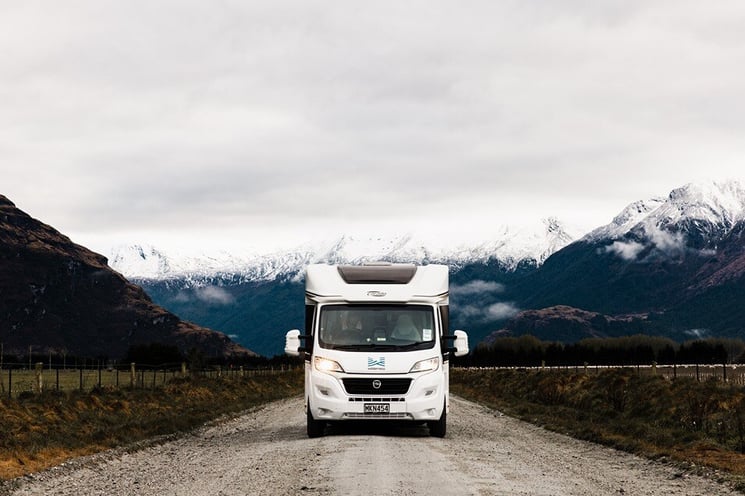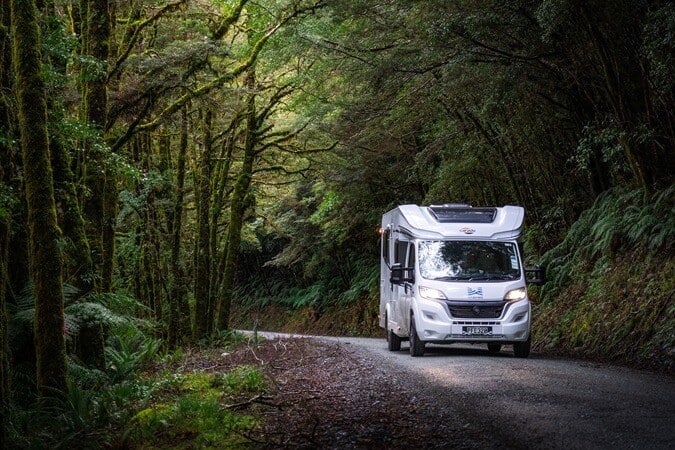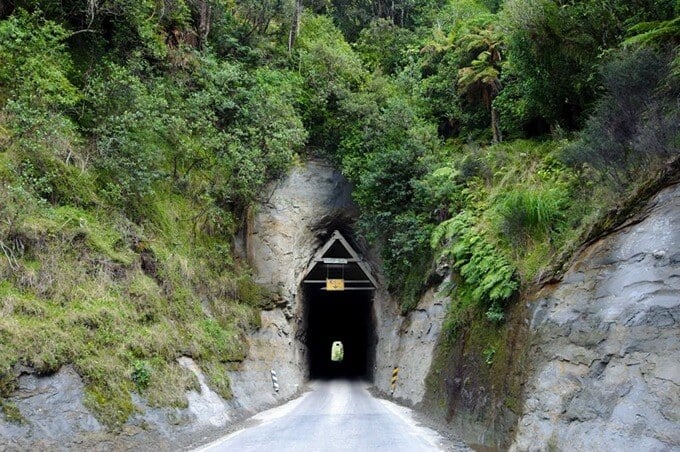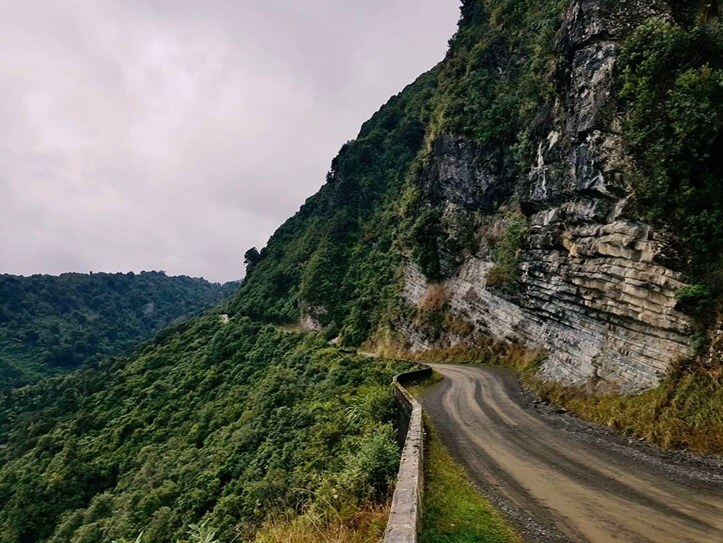
Haven’t you always wanted to explore a country by getting off-the-beaten-track? In New Zealand, you can.
Rather than listing a bunch of prohibited roads, we want to help you experience the real New Zealand. We also want you to stay safe and avoid motorhome damage. Which is why we created this blog — to help you decide whether to drive down a particular road or not.
Read on to discover some of the most unique unsealed routes in the country. You’ll also find out how to avoid vehicle damage on these roads, what insurance cover to consider, and what to ponder when deciding to venture down a back road.
|
Table of Contents |
Most New Zealand motorhome and campervan hire operators place blanket restrictions on where you can drive your hire vehicle. Often these include all unsealed (gravel) roadways and even specify certain roads considered too dangerous to drive. You may also uncover seasonal restrictions — like to ski access roads during winter.
A few hire companies like Wilderness Motorhomes won’t discourage you from venturing onto unsealed roads — and seeing more of New Zealand’s sublime scenery.
These types of roads have a tendency to lead you to remote magical locations. You could discover:
- A secluded golden sand beach
- An isolated high point with a bird’s eye view
- A serene lake amongst native bush.

The risks of driving on unsealed roads
If you haven’t driven on unsealed roads before, it’s wise to take it easy while getting used to the feeling. We’ve outlined some of the risks you’ll face.
Speed
The most crucial variable you can control on unsealed roads is your own speed. The reaction time of your motorhome on gravel is longer than on chip seal. By significantly reducing your speed below the
open road limit (usually 100km per hour), you’ll be able to control your motorhome much easier.
Adjust your expected travel times so they’re more realistic — to avoid finding yourself driving too fast for the conditions.
Visibility
Gravel means dust — and dust churned up by vehicles you pass or follow can impede your visibility. If you’re driving in low light or through shady forested areas, put your lights on low beam so it’s easier for your motorhome to be seen.
Check you have the recirculation button on so you’re recycling air instead of allowing dusty air to enter your campervan.
Loose gravel
Pebbles and loose gravel flicked up as you pass other vehicles pose a risk to your windscreen and headlights. Slowing down will help minimise this risk.
Space
Driving in existing tyre tracks on unsealed roads will reduce your chances of getting into a skid as these have relatively more traction. However, you’ll need to beware of approaching vehicles utilising those same tyre tracks.

Be sure to give oncoming traffic plenty of space as these types of roads are usually quite narrow — in fact, many are only one lane wide.
You’ll need to safely pass so slow down and let the approaching car pull over. Cars are more agile than your motorhome or campervan and will be able to more easily move over — so let the car move to the edge.
|
Skippers Road Skippers Road near Queenstown is one of New Zealand’s most dangerous roads — definitely not suitable for motorhome travel. Miners cut it by hand during the gold rush of the late 1800s. It hasn’t changed much over time and remains 17km of narrow, winding and perilous gravel road. |
Loss of traction
Gravel roads naturally have less traction than tarmac. Speeding, oversteering and rapid braking can cause your tyres to lose traction — to the point where you could feel your motorhome drifting.
If you start to drift, look where you want to go and calmly steer there. The best way to avoid loss of traction is to reduce your speed.
Overreacting
Think about driving in a relaxed manner on New Zealand’s unsealed roads because you don’t want to overreact or make adjustments too quickly. A few tips are to:
- Steer smoothly without swift changes in direction
- Keep an eye out for distractions like birdlife, farm stock, forestry trucks and potholes that could lead you to oversteer
- Avoid hitting the brakes if your motorhome skids — instead gently manoeuvre the way you want to go
- Look ahead early — so you know when vehicles are coming and what obstacles are on the road
- Accelerate and break slower than you normally would on sealed roads.
Learn more about driving a motorhome in New Zealand.
Know what’s excluded with your campervan hire

When you hire a motorhome in New Zealand, you already have comprehensive cover included in your daily rate — similar to when renting a car. But like all insurance, this cover comes with an excess that you’ll need to pay if your motorhome gets damaged. You can use our handy worksheet to compare inclusions, fees and add-ons charged by New Zealand's campervan rental companies.
For peace-of-mind, you may want to consider buying a liability reduction option or an excess waiver. These optional extras reduce or eliminate the need to pay a hefty excess after an accident.
Whether you opt for an excess waiver product or not, it’s important to know the insurance exclusions in your rental contract — particularly if you’re planning to venture off-the-beaten-track. For instance, you may not be covered if you:
- Hit a sizable pothole that scrapes the underside of your vehicle and damages its underbody
- Drive into a low hanging branch and damage the overcab.
Parts like windscreens may require extra cover so you’ll need to be careful driving on loose seal. Check out whether you need extra motorhome rental insurance.
At Wilderness, we won’t discourage you from driving on:
- Conservation campsite access roads — and all other named roads both sealed and unsealed
- Ski field access roads — making ski or snowboard holidays on the country’s spectacular mountain ranges totally available.
These kinds of locations are generally only accessible via gravel roads so you may not be able to get to these locations if you rent from a company that prohibits travel on these types of roads.
|
Unsealed vs off-road Motorhome hires that let you explore rarely seen places accessed by driving unsealed or gravel roads is uncommon. But unsealed roads aren’t the same as off-road. Travelling on a beach, through a river or down a four-wheel drive track won’t be covered. |
Read our insurance details including the liability reduction options, and take a close look at our rental terms and conditions.

Driving restriction benefits come with responsibilities
If your motorhome rental provider’s terms and conditions allow you to decide which roads to drive your motorhome on, your New Zealand adventure may become even more adventurous. But this benefit does come with responsibilities.
You’ll need to carefully assess the weather conditions and which roads you intend to drive on to be sure you won’t end up damaging your recreational vehicle. In order to do that, keep an eye out for:
- Signage — which may indicate whether there’s logging or mining taking place further up the road
- Overhangs — damage from overhanging branches are commonplace especially on rarely-used, winding backcountry roads
- Narrowness — unsealed roads that are both narrow and winding make life difficult for motorhomes and should be avoided
- Potholes — gravel roads have potholes so driving slowly to easily avoid them and researching the road you plan to take is essential
- Fords — some unsealed New Zealand roads have fords which will need to be dry to cross safely when driving a motorhome
- Spots to turn around — check signs at unsealed road entry points plus view offline maps for places to turn around.
If you notice any of the above red flags, you’re best to skip that particular road and search for the next one to lessen the risk of vehicle damage.
|
GPS tracking Many rental operators have GPS trackers installed onboard so if your motorhome or campervan is damaged while driving on a prohibited road, you may not be covered. |

Unsealed New Zealand roads to rave about
Gravel roads are the heart of the New Zealand wop-wops (backcountry). You don’t need to travel far from big city life to find them. But with so many to detour onto, how can you choose the best?
We’ve done some of the research for you and recommend these rarely-travelled treasures.
The Forgotten World Highway — Taranaki/Manawatu Wanganui

To tackle this epic journey through a jurassic-looking environment of unspoiled bush, be sure to fill up your tank before beginning.
The Forgotten World Highway (State Highway 43) from Stratford in the south to Taumarunui in the north is a true relic of New Zealand’s past. Incredibly, it took 50 years to build — opening in 1945.
If you decide to drive this wonderful unsealed road from Stratford to Taumarunui (which is the recommended direction) the town of Toko is your last chance to get gas.
This unsealed patch of New Zealand as it used to be has a great deal of interesting history, geography and society along the way, including the:
- Remnants of several settlements and townships
- Moki tunnel — a 180m long walking experience with a side trip to Mount Dampier Falls
- Tarangakau Gorge — which rises to 500m on both sides
- Magic peaks of Taranaki, Ruapehu, Ngāuruhoe and Tongariro occasionally drifting into view
- Remote republic of Whangamōmona — one of the country’s most isolated spots which has a welcoming feature in the Whangamōmona Hotel.
Plan to blend the Forgotten World Highway into your adventures.
|
Length: 149 km Time: One day Don’t miss: Exploring Moki tunnel |
State Highway 38 - Waikato/Bay of Plenty/Hawkes Bay

For a true wilderness experience in Te Urewera National Park take this partially unsealed road which glides around Lake Waikaremoana. And yes, this road actually is a New Zealand state highway — but it’s also a wonderful scenic journey.
At 219km long, it’s a decent stretch of mostly gravel. Organise to spend the best part of your day navigating SH38 or look into parking up at Lake Waikaremoana Holiday Park or one of the other lakeside camping areas.
Following this special route from the northwest to the southeast, it begins near Waimangu and ends at Wairoa not far from the Pacific Ocean. You’ll enjoy a mix of tarmac and unsealed road — 64kms of it gravel.
It’s a curvy, sometimes narrow highway that you’ll need to traverse slowly keeping an eye on the conditions and any wandering stock. Allow plenty of time for your trip so you can stop and see:
- Locals on horseback
- Lake Waikaremoana
- Dense native beech forest.
Check with the Te Urewera National Park Visitor Centre to ensure the road is open, then take your time cruising State Highway 38.
|
Length: 219 km Time: One to two days Don’t miss: Parking up by Lake Waikaremoana |
Wanaka Mount Aspiring Road — Otago

Raspberry Creek Car Park is 54kms west of Wanaka. It’s also the starting point for some epic hiking adventures in Mount Aspiring National Park. To reach the car park, you’ll need to drive the Wanaka Mount Aspiring Road.
So what makes this South Island unsealed road on the edge of the mountains stand out from others?
There’s something magical about it — an inviting gateway to an outdoor playground in arguably New Zealand’s most magnificent alpine national park. After driving this off-the-beaten-track experience, be sure to check out:
- Wishbone Falls — a 77m tall waterfall with a popular local swimming hole at the base
- Rob Roy Track — one of the country’s best half day hikes to one of its most accessible glaciers
- The local kea — typically cheeky and curious both above the treeline and in the valley where people congregate
- Mount Aspiring — named Tititea by Māori which translates as steep peak of glistening white.
The last 30kms of road are unsealed but mostly flat and wide. Be sure to check the weather forecast as the final 10kms is only a fine weather road with a few fords — meaning the road can get washed out from flooded creeks.
Plan which hikes you want to tackle with the help of DoC’s Matukituki Valley Tracks brochure, then wind your way into the mountains on the Wanaka Mount Aspiring Road.
|
Length: 54 km Time: About one hour Don’t miss: Half day hike to Rob Roy Glacier |
Hakatere Potts Road — Canterbury

In the mountainous west of Mid Canterbury are some easily accessible unsealed roads that lead to the many Ashburton Lakes in the area. One of those stretches of gravel is Hakatere Potts Road — the road to Mount Sunday.
A day trip from Christchurch or a half day adventure from Methven, this route has plenty to offer including:
- Lake Clearwater — with tramping, fishing and watersports all popular outdoor activities
- Expansive views of the braided Rangitata River
- Mount Sunday — the photographic reward at the end of your journey.
The setting for Edoras during the Lord of the Rings movies, Mount Sunday is a prime reason why you’d choose to hit this unsealed road. Carved out by glaciers, the hill got its name because boundary riders from high country stations used to meet there on Sundays.
Follow the Ashburton Gorge Road from Mount Somers through the foothills until it becomes Hakatere Potts Road and changes to gravel. Check the weather forecast and whether there’s been recent rain as there are a couple of shallow fords to navigate.
Take a look at our Lord of the Rings South Island campervan itinerary for some iconic locations to visit.
|
Length: 25 km Time: About one hour Don’t miss: Short hike up Mount Sunday |
Choosing which gravel roads to drive down and which ones to avoid essentially comes back to commonsense. Weigh up the risks of heading down any unsealed road knowing you’ll be fairly isolated and you may have limited mobile phone coverage — but that you’ll also be experiencing the real New Zealand.
|
Need help comparing NZ campervan rental companies? Download our comparisons worksheet so you can easily match restrictions plus all other things Wilderness offers compared to other rental motorhome and campervan options. |




